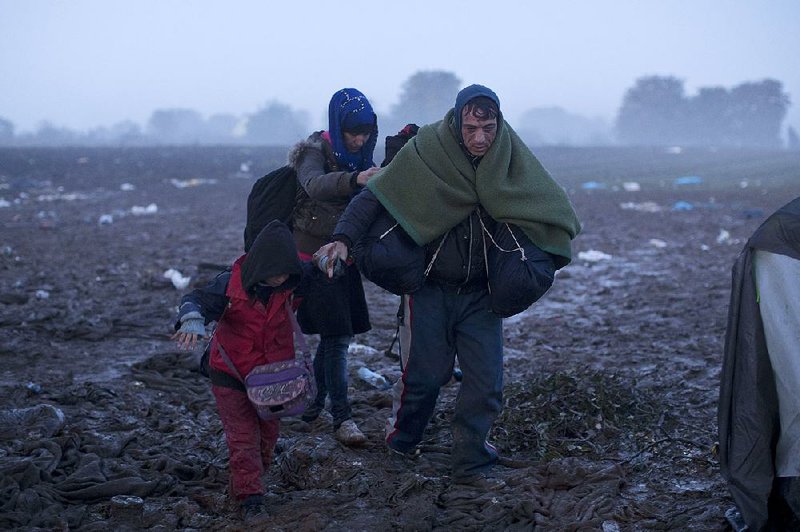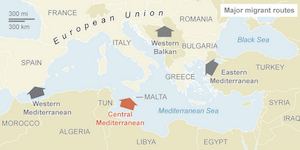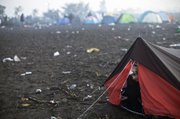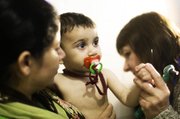BAJAKOVO, Croatia -- Serbia and Croatia agreed Friday to increase the flow of asylum seekers over their border after thousands spent a muddy night in the open during near-freezing temperatures.
The two nations' interior ministers said they will start shipping migrants by train directly from Serbia to Croatia so the travelers won't have to cross on foot, often trekking miles in the rain and cold weather.
"We have agreed to stop this torture," Croatian Interior Minister Ranko Ostojic said. "There will be no more rain and snow; they will go directly from camp to camp."
The surge is showing no signs of abating. The International Office for Migration said Greece just experienced the largest single weekly influx of migrants this year, an average of 9,600 people per day compared with between 4,000 and 6,000 per day in September.
European Union officials have called a summit for Sunday of several EU and Balkan leaders to focus on the migrant crisis. German Chancellor Angela Merkel and leaders from nine other countries aim to agree on measures that could become operational as early as Monday morning.
"There's a real problem on the ground" along the route, European Commission spokesman Margaritis Schinas said Friday in Brussels. "It is that region that will benefit from people meeting face to face, to talk and to see what can be done."
United Nations High Commissioner for Refugees Antonio Guterres; Fabrice Leggeri, the executive director of EU border agency Frontex; and European Asylum Support Office Executive Director Robert Viser also will participate in Sunday's gathering.
Tensions have been building after the Balkan route into Western Europe shifted when Hungary decided early this week to close its border with Serbia to migrants. They still cross from Turkey to Greece to Macedonia to Serbia, but now they go via Croatia and Slovenia instead of Hungary, which has erected high, razor-wire fences along its borders with Serbia and Croatia.
The actions have led to bottlenecks with thousands of migrants, mainly from the Middle East and north Africa, massing in outdoor border areas overnight. Agreeing to the provision of shelter is one of the objectives of Sunday's meeting in Brussels, according to a EU official.
In the future, migrants will register when they enter Serbia and will be able to cross into Croatia without delays, which should speed up the process significantly, the interior ministers said.
Farther west, thousands of migrants aiming to reach northern Europe walked out of camps on the border between Slovenia and Austria on their own, frustrated after waiting long hours in overcrowded facilities.
Thousands spread out Friday along railway tracks, highways and mountain roads. Confused about what roads to take, some migrants later turned back and returned to the camps to wait for buses to other locations.
Overwhelmed after more than 50,000 migrants crossed in just a week, Slovenia said it has not ruled out erecting a fence of its own along parts of its 400-mile border with Croatia. Prime Minister Miro Cerar was quoted Friday as saying Slovenia will consider all options if left on its own to cope with the influx of thousands of people.
"Our sights are foremost on finding a European solution," Cerar said. "But should we lose hope for this ... all options are open, within what is acceptable."
The country of 2 million people already has deployed 650 army troops to help police manage the flow and has asked the European Commission for $68 million in aid, police gear and personnel.
Slovenia and Croatia have traded barbs since the start of the crisis, with Slovenia accusing Croatia of dropping migrants at its doorstep.
Croatian police Friday were seen escorting about 1,500 migrants close to an unmanned section of the country's border with Slovenia before letting them cross on foot. The group arrived on a train and was led by police to a small bridge to cross into Slovenia, where they will be taken to a collection center.
At the Serbian border, 5,000 people gathered around fires, under tents and wrapped in blankets as they waited all night to cross into Croatia. One elderly resident of the Croatian village of Kljuc Brdovecki said it was heartbreaking to see the migrants in those conditions.
"They are truly miserable. When I watched them walking past one night, I got up to watch, I watched and cried," Jela Karic said. "They walked this way, tired to the point of sleeping, in the middle of the night. When you watch them, all you can do is cry."
Serbian Interior Minister Nebojsa Stefanovic said his nation and Croatia will ask the EU to recognize the Serbian registration process -- which includes finger and palm printing and biometric passes -- so migrants don't have to undergo the same procedure repeatedly.
"With the winter coming, it is important to agree on a speedy flow of these people," Stefanovic said.
Reports of abuse
Among hundreds of thousands of migrants pouring into southeast Europe are women and children who the U.N. refugee agency warns are vulnerable to abuse. The agency said Friday that it has received reports that some are being forced into sex to pay their way onward.
The office of the U.N. High Commissioner for Refugees cautioned that it doesn't have a full grasp of how widespread the problem is, but it said women and children traveling alone who are short of cash and sleeping in places such as parks and train stations are particularly vulnerable. Some authorities, it said, have increased the risk for children by placing them in detention along with adults while they wait for official processing of asylum applications.
"From testimony and reports we have received there have been instances of children engaging in survival sex to pay smugglers to continue their journey, either because they have run out of money, or because they have been robbed," the U.N. agency said in a statement.
Spokesman Melissa Fleming said some testimonies came from "overcrowded reception sites" such as in Greece. She said it is assessing how many children might be affected, but it was going public with the concerns to pressure governments along the route to do more to help children.
"This is the stage where we are raising the alarm bell," she told reporters. "This has been gathering."
The extortion of women and children appears to be happening "in every single country" along the route -- mainly through the Balkans -- and it appears that smugglers, criminal gangs and other migrants could be behind the abuse, she said.
"We are calling on all concerned national authorities in Europe to take measures to ensure the protection of women and girls and children," she said.
Fleming said one colleague in Greece was spending time walking up and down rows of people arriving to make sure "vulnerable people are identified." She said another colleague in Sweden -- where a more open policy toward migrants has made it a top destination -- said that 500 unaccompanied minors recently were arriving each day.
"You're seeing these desperate cases of parents sending their children ahead at really young ages," Fleming said.
The U.N. agency has acknowledged the difficulty in counting what it calls "unaccompanied and separated children" -- much less knowing how many have been abused.
Information for this article was contributed by Radul Radovanovic, Ali Zerdin, Sabina Niksic, Ivana Bzganovic, Jovana Gec, Petr David Josek, Balint Szlanko and Jamey Keaten of The Associated Press and by Ian Wishart, Tony Czuczka, Patrick Donahue, Sheenagh Matthews and Jonathan Stearns of Bloomberg News.
A Section on 10/24/2015



